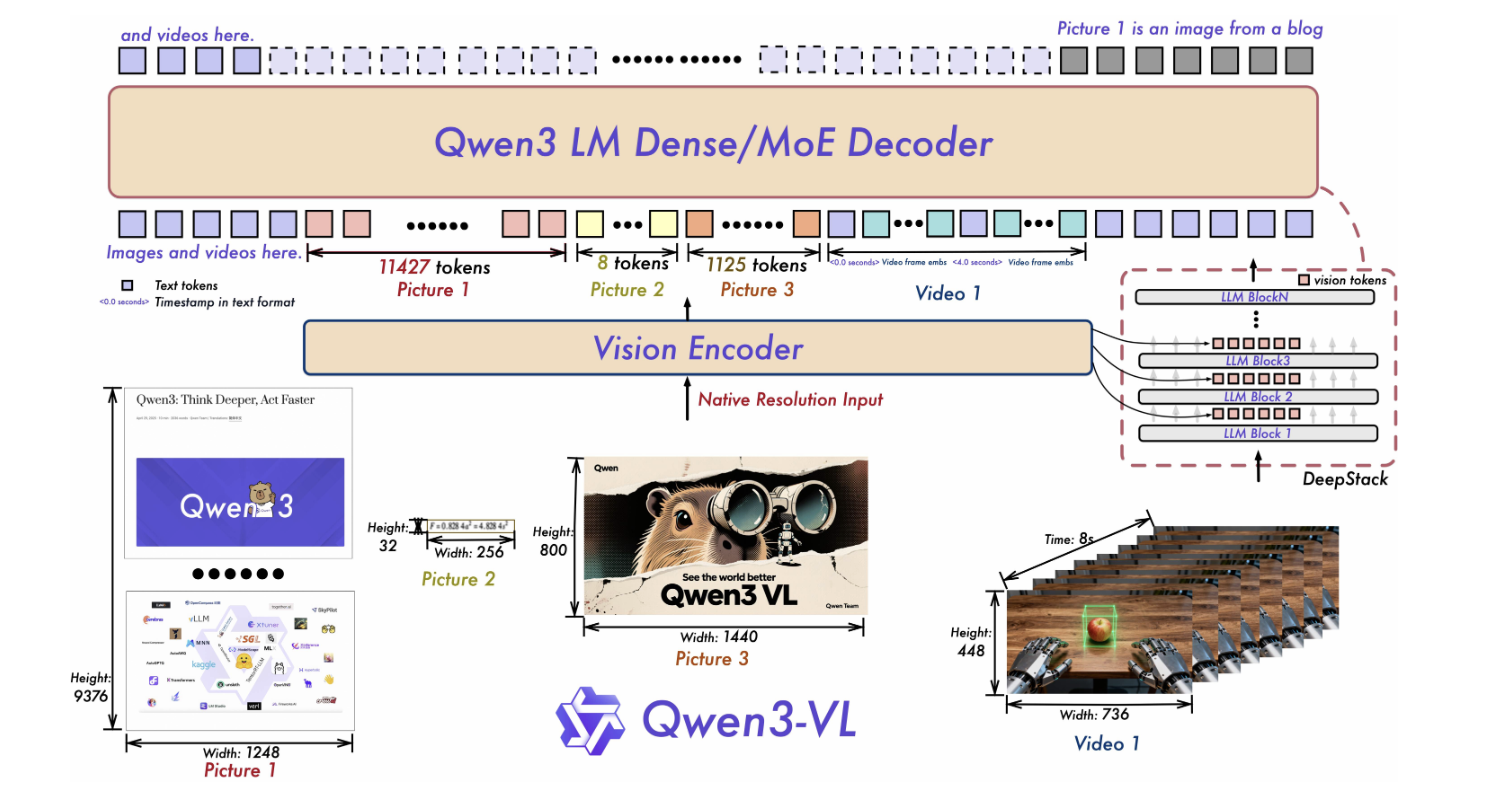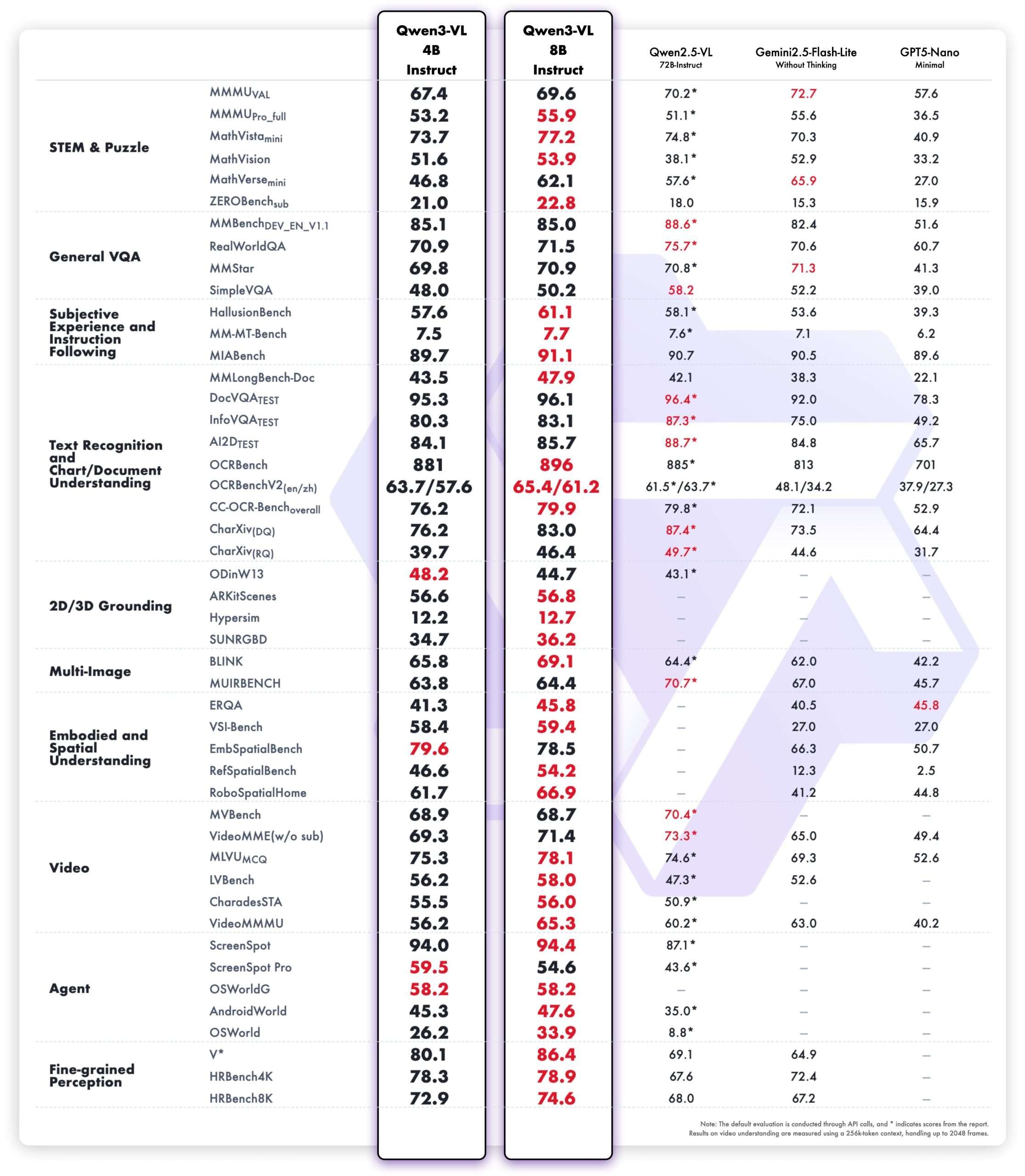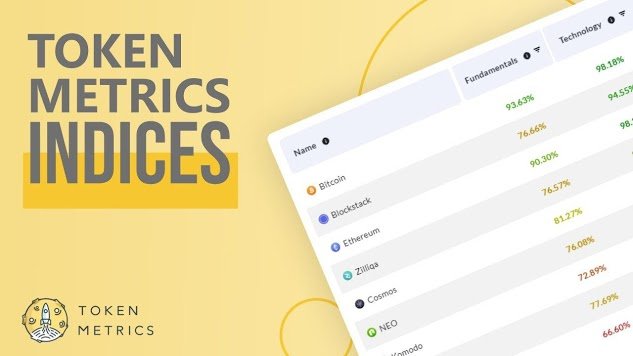Do you actually need a giant VLM when dense Qwen3-VL 4B/8B (Instruct/Thinking) with FP8 runs in low VRAM yet retains 256K→1M context and the full capability surface? Alibaba’s Qwen team has expanded its multimodal lineup with dense Qwen3-VL models at 4B and 8B scales, each shipping in two task profiles—Instruct and Thinking—plus FP8-quantized checkpoints for low-VRAM deployment. The drop arrives as a smaller, edge-friendly complement to the previously released 30B (MoE) and 235B (MoE) tiers and keeps the same capability surface: image/video understanding, OCR, spatial grounding, and GUI/agent control.

What’s in the release?
SKUs and variants: The new additions comprise four dense models—Qwen3-VL-4B and Qwen3-VL-8B, each in Instruct and Thinking editions—alongside FP8 versions of the 4B/8B Instruct and Thinking checkpoints. The official announcement explicitly frames these as “compact, dense” models with lower VRAM usage and full Qwen3-VL capabilities retained.
Context length and capability surface: The model cards list native 256K context with expandability to 1M, and document the full feature set: long-document and video comprehension, 32-language OCR, 2D/3D spatial grounding, visual coding, and agentic GUI control on desktop and mobile. These attributes carry over to the new 4B/8B SKUs.
Architecture notes: Qwen3-VL highlights three core updates: Interleaved-MRoPE for robust positional encoding over time/width/height (long-horizon video), DeepStack for fusing multi-level ViT features and sharpening image–text alignment, and Text–Timestamp Alignment beyond T-RoPE for event localization in video. These design details appear in the new cards as well, signaling architectural continuity across sizes.
Project timeline: The Qwen3-VL GitHub “News” section records the publication of Qwen3-VL-4B (Instruct/Thinking) and Qwen3-VL-8B (Instruct/Thinking) on Oct 15, 2025, following earlier releases of the 30B MoE tier and organization-wide FP8 availability.


FP8: deployment-relevant details
Numerics and parity claim: The FP8 repositories state fine-grained FP8 quantization with block size 128, with performance metrics nearly identical to the original BF16 checkpoints. For teams evaluating precision trade-offs on multimodal stacks (vision encoders, cross-modal fusion, long-context attention), having vendor-produced FP8 weights reduces re-quantization and re-validation burden.
Tooling status: The 4B-Instruct-FP8 card notes that Transformers does not yet load these FP8 weights directly, and recommends vLLM or SGLang for serving; the card includes working launch snippets. Separately, the vLLM recipes guide recommends FP8 checkpoints for H100 memory efficiency. Together, these point to immediate, supported paths for low-VRAM inference.
Key Takeaways
- Qwen released dense Qwen3-VL 4B and 8B models, each in Instruct and Thinking variants, with FP8 checkpoints.
- FP8 uses fine-grained FP8 (block size 128) with near-BF16 metrics; Transformers loading is not yet supported—use vLLM/SGLang.
- Capability surface is preserved: 256K→1M context, 32-language OCR, spatial grounding, video reasoning, and GUI/agent control.
- Model Card-reported sizes: Qwen3-VL-4B ≈ 4.83B params; Qwen3-VL-8B-Instruct ≈ 8.77B params.
Qwen’s decision to ship dense Qwen3-VL 4B/8B in both Instruct and Thinking forms with FP8 checkpoints is the practical part of the story: lower-VRAM, deployment-ready weights (fine-grained FP8, block size 128) and explicit serving guidance (vLLM/SGLang) makes it easily deployable. The capability surface—256K context expandable to 1M, 32-language OCR, spatial grounding, video understanding, and agent control—remains intact at these smaller scales, which matters more than leaderboard rhetoric for teams targeting single-GPU or edge budgets.
Check out the Model on Hugging Face and GitHub Repo. Feel free to check out our GitHub Page for Tutorials, Codes and Notebooks. Also, feel free to follow us on Twitter and don’t forget to join our 100k+ ML SubReddit and Subscribe to our Newsletter. Wait! are you on telegram? now you can join us on telegram as well.
Asif Razzaq is the CEO of Marktechpost Media Inc.. As a visionary entrepreneur and engineer, Asif is committed to harnessing the potential of Artificial Intelligence for social good. His most recent endeavor is the launch of an Artificial Intelligence Media Platform, Marktechpost, which stands out for its in-depth coverage of machine learning and deep learning news that is both technically sound and easily understandable by a wide audience. The platform boasts of over 2 million monthly views, illustrating its popularity among audiences.

